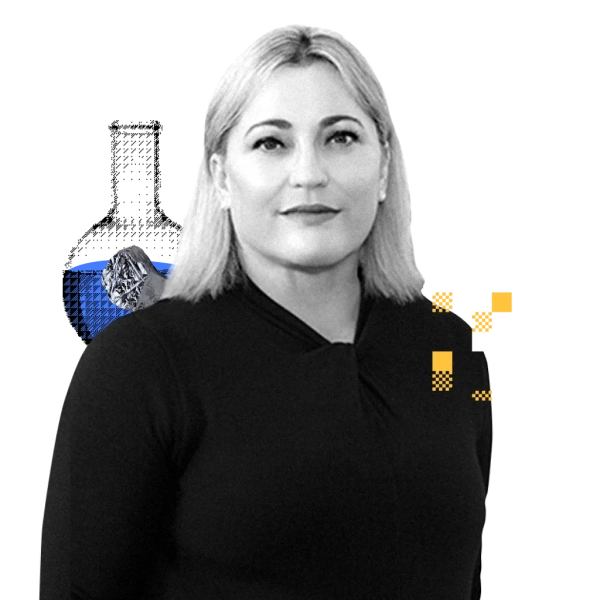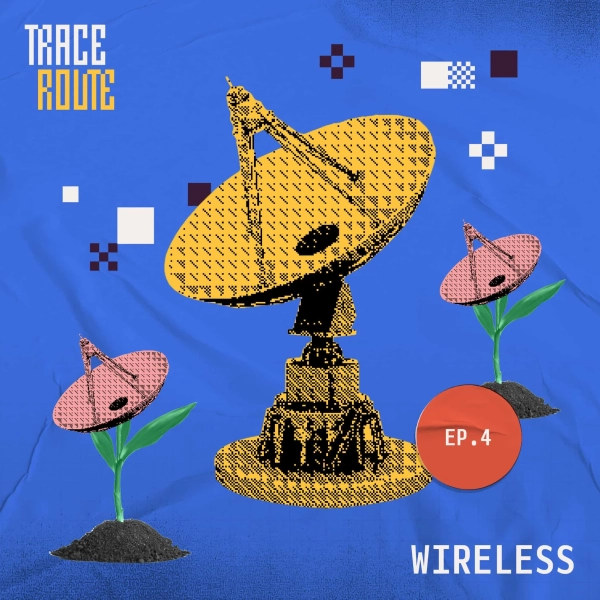When we picture computing technology in the 70’s and 80’s, we think of nerdy, ambitious, young visionaries, burning the midnight oil in some suburban garage, striving to revolutionize the world by perfecting the motherboard. And the material that would eventually ignite that revolution? Silicon.
In episode 2, we take a closer look at the material that changed the world. From the earliest discoveries at Bell Labs to the cutting-edge processors that run the Cloud, silicon has become the material that democratized access to information and gave rise to the technology we know and rely on today.
JAMES [00:45:12]
Silicon is central to a lot of those things that people are silicon is central to enabling those things, it's central to giving power and giving giving a platform for those things to happen on a broad based way. Right. It democratizes things that were otherwise held for the very special few scientists and labs. That's what silicon does. It democratizes things. So a broad base of of developers and or customers have access to them. Silicon is central to giving power and giving a platform. It democratizes things that were otherwise held for the very special few scientists in labs.That's what silicon does. It democratizes things. So a broad base of of developers and or customers have access to them.
This is Traceroute [rowt]...a podcast about the inner workings of our digital world - all the physical STUFF that most of us never have to think about. In a world that is increasingly defined by digital.... We look at the real people and services building, maintaining, and scaling the internet. I’m your host, Grace Ewura-Esi. a technical storyteller and product evangelist at Equinix.
In this episode: SILICON.
[Act I: ]
To learn about the role that silicon plays in today’s internet, we’ll begin with a little girl... watching her dad tinker with tech.
JAMES [00:03:26]
I grew up in Silicon Valley and never imagined that I'd work in semiconductors. Renee James grew up alongside the computer industry...watching it become a huge part of the American economy.
JAMES [00:02:43]
I'm the CEO of Amper Computing, which is a rare company in the sense that it's a startup semiconductor company building high performance microprocessors for the cloud
A lot of us have a picture in our mind of what the 1970s and 80s were like in Silicon Valley. We can imagine Steve Jobs and Woz in a garage, working into the night to perfect a motherboard. Nerdy, ambitious, passionate people graduating from Stanford and starting jobs. And people working to improve technology - which could then improve the world. That little girl.... At the time... wasn’t interested.
JAMES [00:03:26]
My dad. He used to work at HP and he used to like to go to Fry's Electronics and build motherboards and build computers. .//that was something that my friends, dads and my dad did and was kind of nerdy and they were pocket protectors And so that's what I grew up with. But when Renee James did grow up, she joined the industry she never expected to love.. She went on to a storied career at Intel. And now heads up another semiconductor company.
And whether’s she’s working at a major corporation or hustling for her own start- up, one material has stayed constant....
In an age of cloud computing, edge computing, and a future we can’t even imagine yet... silicon is just as vital now as it was then.
[ACT II]
The story of silicon - the hard, brittle crystalline semiconductor that makes up transistors...which makes up chips... which make up computers... It starts before the 70s and 80s in what would become Silicon Valley. It starts with Bell Labs....the company named after Alexander Graham Bell, the inventor we all learned about in history class...
GERTNER
And the company that grew out of that in the United States was American telephone and Telegraph, which effectively had a monopoly and controlled pretty much all of the telephone service in the United States
Jon Gertner is a journalist and author. And he wrote the book “The Idea Factory: Bell Labs and the Great Age of Innovation.”
GERTNER AT&T, as it was known then//created a research and development lab in 1925, and that was called Bell Telephone Laboratories The lab started as a group of scientists and engineers that looked to create a national phone system.
GERTNER [00:05:32]
You know, how do you connect everybody to everybody? How do you create both the hardware and what we now call the software? // But as the, you know, R&D lab, as Bell Laboratories evolved, it became in part a sort of place for ideas, a place for thinking further ahead into the future. What could communications be?
Gertner says that due to its monopoly, the lab had a unique culture, and that was a huge reason for its long term success.
GERTNER [7:00 ish]
So they could you could say, well, they didn't have competition, so they didn't have to be as innovative. You know, they weren't sort of, you know, jockeying to beat the competition to come up with something first// What it allowed them to do was to sort of think really long term and to plan for innovations that didn't necessarily happen quickly, but could be thought of in the far distance// [it was a kind of blue sky moment where you had to create something because nothing really existed at that point in time] They were able to solve for short-term problems like connecting up phone lines but also imagine, and sit, and really think about what the future would be.
GERTNER they didn't speak in terms of ideas. if you ask some of the scientists decided, you know, why did you come up with so many technologies to change the world? // They had a lot of people with great ideas, although they did, but it was that they had really great problems to solve. There was no national communication system like this anywhere in the world, and they had to create it almost from scratch
Inventions that came out of Bell Labs over the years include thousands of patents. And dozens of life-changing ideas - the theory behind lasers, cellular telephone systems... communication satellites... and the early belief that it would someday be possible to send packets of information digitally. One of Bell Lab’s major breakthroughs was the transistor.
GERTNER [00:13:14]
And if you walked into a switching center in, say, 1930, you would see these enormous banks of switches that would connect basically everyone to everyone else.
And this sort of fiendishly complicated system relied on these relay switches and it relied on these vacuum tube amplifiers to actually make it work. The idea of the transistor was to use some kind of new material, something that didn't sort of have moving parts. // when we say that the transistor is the building block of all electronic products, we can sort of just say what it was// was an amplifier and it was a switch that replaced the vacuum tube and it replaced these electromechanical relays. It made everything smaller, it made it faster, and it made a better
And what was that new material that would make transistors work? That tetravalent (te-TRAVEL-ent) metalloid (metal-loid) we know as silicon. The lab had been playing with different materials for a while. Things like copper and silver. Others were insulators - like glass. But there was a third class of materials that would become important - semiconductors.
GERTNER [under certain circumstances, they acted like conductors. Under other circumstances, they didn't. It was pretty clear also early on that they were valuable for some kinds of devices like wireless radios, that you could create crystals that would serve as a vital part known as a rectifier within these early wireless radios in World War Two, these pieces of silicon as well, or sometimes germanium, which is also a semiconductor, were used in radar sets] As early as the late 1930s, some experts guessed that these kind of semiconductors could be useful in the phone system - but they weren’t sure how.
GERTNER [00:16:31]
And William Shockley, who later became the sort of fundamental driver of what was called Solid-State Electronics at Bell Labs, would try experiments in the 30s and 40s, early 40s to try and understand how can I make a piece of semiconducting material turned into an amplifier. And he would kind of, you know, get his experimental expert friends to help him in his lab and he wouldn't get anywhere. It proved to be very difficult. It took years of experimentation to really get anywhere with silicon and transistors.
GERTNER [00:21:17]
You can't just use natural materials that you find around. And if you go back to, say, Thomas Edison's lab and, you know, visit it, you can sort of see in his store room that he was trying all these natural materials as like filaments and, you know, horsehair and hooves and pieces of other sort of minerals. But I think what happened in the 30s and 40s of Bell Labs was this clear understanding that we had to manipulate materials to make them work for our systems, these communication systems that were really just beginning. And that really sort of formed, I think, the backbone of electronics and the backbone of these, you know, vast interconnected communication systems// It's actually this sort of decades long or almost century long pursuit of understanding, you know, the kinds of materials we needed to create the system] People throughout Bell Labs - metallurgists, materials scientists, workers at obscure branch laboratories - they were all playing around with materials and testing out what they could do. And after years of work, there was a breakthrough: putting a tiny impurity into some of these semiconductive materials could actually change how they worked.
GERTNER [they call this a functional impurity that if you put just one tiny like a millionth of a percent of a material and what we now call doping into silicon or germanium, it would change the function of it] The very early transistors were made of germanium.
GERTNER [00:22:41] Early on, however, they realized that silicon would be a
better material and it really took a few years to actually created Silicon Transistor. And there were a number of reasons why silicon was better. I mean, germanium is a very rare material. For instance, in silicon is very plentiful. What was most crucial, I think, for the people at Bell Labs and for the electronics industry was that silicon is much more resilient and sort of high heat environments. More Tannenbaum, who was really the first guy created the first silicon transistor, said, you know, we knew before we created it that if we could figure out how to make a silicon transistor, it would work even in boiling water. Once transistors were perfected, there was still a lot of work to be done. They had the material - but to borrow a popular term from today... *SCALING wasn’t so simple.
GERTNER [I'd say it was about a good 10 years before the first transistors started rolling off the line. And we have to remember, these weren't integrated circuits. They weren't like what Intel was making where there's billions of transistors. These were like single individual transistors. And it really wasn't until a good number of years after that that that we had these breakthroughs with, you know, stuffing thousands and then millions of transistors on a chip]
Gertner is careful to point out that all of these breakthroughs might not have happened without the particular circumstances around Bell Labs.
GERTNER it was understood pretty early on that failure was going to be part of the process and at least in the research department, unless you failed over and over again for decades on end, I mean, you wouldn't necessarily be penalized for sort of trying something that didn't work. So a culture of patience was also, I think, a culture of understanding that when you were creating new technology, when you're seeking to solve a really difficult problem, the answer would not come easy and the answer might take a very long time] The culture and output of Bell Labs would have lasting impact on how the technology industry developed. And though it seems a long way away from our internet-addicted lives today, we can’t forget Bell Labs’ legacy, says Gertner. Even if Bell Labs didn’t exactly get on the internet train in the early days.
GERTNER. They didn't really see the great potential of the Internet. This was a sort of decentralized communications network that was very different from the phone system in the way that they had thought of of of their organization and their system that they had created. You know, I remember this story. Somebody told me where some Bell Labs executives were talking about the Internet and they kept saying, well, who's in charge? And the answer was, well, no one's in charge. And, you know, this was just a thought that was sort of unthinkable to them] As for the material they developed that would change the world...
GERTNER [00:32:02]
silicon is sort of the fundamental material of our age// More on silicon... after the break.
[Act III Building Compute]
But if we go back to that little girl in Silicon Valley, we start to understand why these early innovations allowed for technology to evolve so rapidly from the 1970s on. Renee James had a front row seat to it all. James: [// over the course of the last several decades, it's gone from a hobbyist, something that people who were super into computers and believed that people could have computers everywhere too.
[00:04:19] And, you know, an essential part of our lives, the same way that we think about electricity or having a car or, you know, something like that. People just think about having computing. Like, of course, you have a phone, which is a computer. Of course you have a laptop. Well, if you go if you roll it back to the beginning of our industry, I entered the industry right at the time that the PC was just starting to take hold. And it was phenomenal that average people could actually have access to computational technology to help them do their everyday tasks
James remembers a life-changing project that happened very early in her career.
James [00:27:00]
You never know that this is it until in retrospect, you look back and you thought, well, I could have retired it at 23, my first project after Intel acquired the company She had been working at a company building workstations - and that company was acquired by Intel.
James [because my dad had been a hobbyist and he worked at HP and I was really comfortable with a soldering iron and working on it was a startup, we all did everything right. When I got to Intel, I always had a really, I would say, an affinity for figuring out how we could use the technology to do something people hadn't done before] She was assigned to work on a project - to figure out how to get audio and video to stream on a PC. It already worked on mac.
James [00:27:55]
And the PC, you know, no one really believed that the PC could even maybe play video or audio back.
[00:28:29]//we basically made video and audio work on the PC and it was called Video for Windows. That was an ad on product too early, you know, Windows. And then it became, of course, the integrated, you know, framework for how how you just stream something like Zoom or what have you back on it on a PC through windows, but. I have to say, when that first video and it was a video of a guy windsurfing in the Columbia Gorge with music when it played back and it was crucified, very small video and I think it was 16 frames per second, maybe 12. And, you know, Real-Time video is 30 frames per second or better or else you can tell that it's not at the right speed and it played.
[00:29:46] In that moment, it changed everything. And there I was like, I don't know, not very old and who knew right at that moment that was probably the most important breakthrough that we would make for the next couple of decades of computing, because all of the applications that came after it, you know, just just phenomenal. And it was a really big deal] James could already see how developments in silicon and transistors could change the way we used computers... and lived our lives. [00:05:00] the way that we think about using a computer today, of course, we're going online and we're chatting with our friends and we're doing gaming and we're video conferencing. God help us all day long during the pandemic. But that phenomena is relatively new. I mean, it's only, you know, the last, you know, 18 years or so
The layers of work and infrastructure required to run the internet today, says James
- we owe it to silicon.
James [One thing that I think people don't understand about silicon, it's like, oh, why do we want. Why do we care about semiconductors at all? We don't care. We want to use Google. We want to use Facebook. We you know, we're doing all this other stuff. We don't care about you semiconductor people. It turns out it is the essential building block of computing. And it is the thing that everybody needs to do, everything from electric vehicles to, you know, finding life on Mars, to discovering cures for cancer and playing games on with your friends
Obviously, the shift from personal computing to the cloud and smartphone- centered world we live in today, didn’t happen overnight. Chips had to get more powerful, more cost effective, and more pervasive.
James [00:09:41]
Chips have gotten transistors have gotten smaller, so you can put more of them on a chip. Chips have not necessarily gotten smaller, but there's more transistors per chip and each transistor gives you more performance.
[00:09:56] And you can have specialized transistors or features that do things like accelerate graphics or accelerate security or, you know, different things that were important to the evolution of of software, being able to support multiple streams of video, being able to support audio, getting getting all of that to happen in a way that distributed that compute power across the microprocessor so it didn't get bogged down and it would drop packets and people would only see, you know, one small picture versus the full screen, et cetera. As chips improved - so did microprocessors.
James [00:07:05]
There's lots of different kinds of semiconductors. But the but the king, the king of the Hill, if you will, is is the microprocessor, which is the brains of the computer, had to get to the point where it was accessible to enough people that that in a cost effective way and which really happened with desktop computers]
An important step along the way was the fifth generation of the microprocessor, the Pentium. That microprocessor was available in PCs in conjunction with windows. So improvements in chips really allowed for a change in human behavior and leisure or work time.
James [00:08:09]
The user interface was just a lot easier for people to to be able to get on the Internet, use the keyboard, have an experience that was different than typing a document or working on a spreadsheet. And that really became the advent of what I would say, broad based coders starting to use the power of the network to build the upper level applications that are the cornerstone that we think of today. The websites that we think about, the tools that we think about, even the communities, you know, like, you know, the early predecessors to Facebook and and to Google, that those communities sprouted up from that period. Despite this rapid growth, the materials that make up computers - have remained relatively stable.
James [00:14:27]
How you combine them evolves over time for, you know, in future generations. Certainly even more new material science has to continue to evolve. I think the biggest development in the last decade or so has been around how to architect and use those transistors in the most efficient way, you know, to really work on power and power distribution and take into consideration what's going on in a data center
You heard that right - innovation in silicon and transistors - actually helps power the ever-growing internet. It’s something James thinks about each and every day as she runs Ampere, which focuses on cloud computing.
James [if you think about a cloud, it's run out of a data center somewhere in the world or multiple places in the world that are racks and racks and racks of computers that have to be cooled in order to stay at the right ambient temperature so that the semiconductors don't overheat. So the more power efficient and lower power that we can make these massively powerful machines, the better it is, the easier it is to cool, the better power management you have inside your data center in the lower cost it is to operate them. //How do you get the most performance at the right power and the most density, meaning the most number of transistors or cores, if you will, at the right power?] Despite their key role in all things computing, why do silicon and transistors continue to be overlooked? - why is it that so many people ignore the hardware involved in pushing the internet forward? Maybe because it’s just a lot harder to manipulate....
JAMES [00:18:38]
Chip design is complex. // It requires a lot of creativity, each generation to come up with what's going to be new and how to how to lay it out, where to put things, what to do, how to continue to innovate. And it's definitely a very competitive. Process, but I have to say there's there's a tremendous amount of artistry to it in the sense that the computer scientists and the physicists and the architects who do this work in many, many ways, they are are dreaming up what's possible.
Complicated or not, these materials deserve more time in the spotlight.
[Act IV: The Future of Silicon]
JAMES [00:30:57]
OK, well, I mean, besides your phone, besides your laptop, besides your car, your refrigerator, your home, your I don't know, your whole life, maybe your toothbrush, maybe not. You know, how it silicon powers everything. Different kinds of silicon. Right. Whether it's radio silicon that powers your cell phone. There's a microprocessor also in the in the phone there's a graphics processor in the phone and there's a wireless processor in the phone. There's the same, you know, your MacBook or whatever you're using. So silicon is everywhere.// It's absolutely everywhere. And not all silicon is created equally.
The level of complexity of advanced silicon or microprocessors is at one end of the spectrum and cloud. And the data centers that run the cloud tend to be built on the most advanced, most demanding silicon available in the market today. Because of the performance and the real time nature of the response and the applications that are running in the cloud and the scale of the cloud, et cetera// The cloud - the place where most of us are computing today - still needs innovation in chips, in processors, and in computers - to continue to improve. It’s where James and her company have focused their efforts.
JAMES [00:10:45]
We've built the first processor that was 100 percent built to serve cloud software. So that's a different level of performance, a different way of structuring the microprocessor and actually specific features that accelerate and assist cloud software. And that's been the history of semiconductors that you can every generation you can make it more performant, more more powerful to give the software the horsepower it needs to get better and better, but also put in special features to assist different kinds of applications] Cloud computing is only a piece of the picture. Advances in the way we use silicon... will also mean advances in how we use our devices, and the internet itself. There is a lot left to do.
JAMES [there are things in software you cannot do because you don't have enough performance. Right. And you hear a lot about that in artificial intelligence and in different areas of research where they're pushing the outer boundaries and they have to cluster together computers and they have to tie together different kinds of processors to get enough horsepower. Those are those are the things that we live for. We live for people building the next thing that's going to get us to demand from us as microprocessor people to build something even better] James says it’s an exciting time to work in the space. Market segments are growing. Applications in spaces like AI abound. Innovation spurs more innovation.
James [00:41:01]
I think that we're seeing a bit of a renaissance of of an interest in computer design.
[00:41:27] //for, you know, probably the last 10 years we've heard so much about all these cloud companies. And you're like, yeah, and there would be no X, Y, Z without like, what are we chopped liver over here? I mean, you know, here here's you know, this, you know, a company building all this stuff so you can do wayI. And here's a company is building all this stuff so you can do incredible things that, you know, in compute. And no one says a word about them. They never say boo. They're like, oh yeah, we can. We're this great software company. We're worth a bazillion dollars. And you're like, Really? That was not really that complicated. How about you put 30 billion transistors down and make that thing turn on and work? And all that new energy in the space, is also exciting for James, who has dedicated her life to the industry.
###JAMES [00:19:47] So I find the innovation in semiconductor technology to be inspiring because they're they have to imagine a future that doesn't exist and then make it come true. And in that sense, there's nobody who came before them. And it's as it is so complicated and that complexity is lost on most people, they think, oh, yeah, you know, people make chips super easy. You put them in a laptop, it turns on. It works perfectly. Yes. If only that were true. // we're talking about tens of billions of transistors in each one of these things, and a transistor is not visible to the naked eye. I mean, it is that small. It is that complicated. And it enables us to know things we couldn't have known before, to find things we couldn't find before, to do things we couldn't do before.
Next time on Traceroute...
[Bachar: I was giving a presentation about cloud, the cloud services that we had and how we actually do doing cloud and all those things and and expanding data centers, explaining how data centers work and why we need data centers to a group of software engineers. And one of them that just asked me a question is. If we're running in the cloud, why do we need data centers?]
Thanks for listening to Traceroute, an Equinix production. Our theme music is by Ty Gibbons.
Be sure to subscribe in Apple, Spotify, or wherever you get your podcasts. You can learn more by heading to metal dot equinix dot com slash traceroute. Want to get in touch? Reach out to us at [metal dot equinix dot com]. And make sure to leave us a review and tell us what you think.





